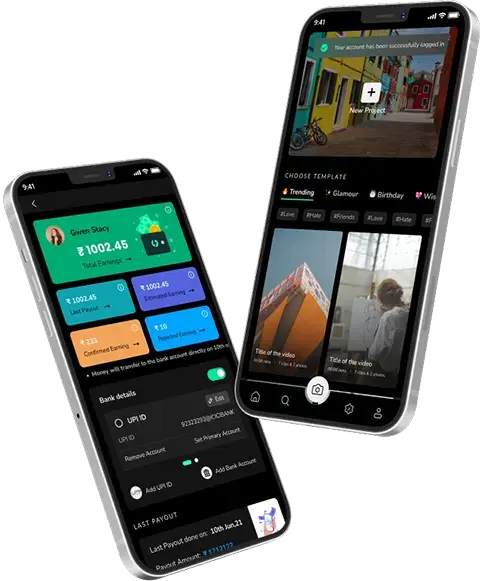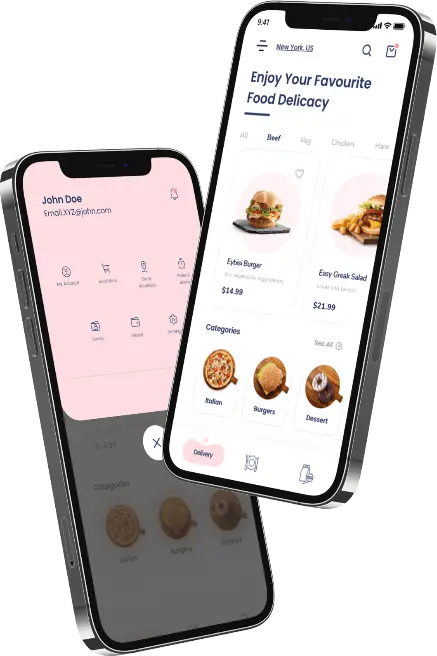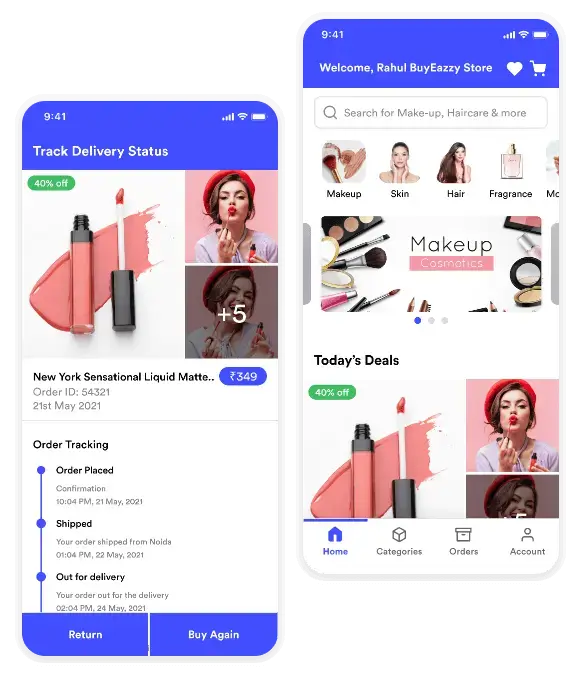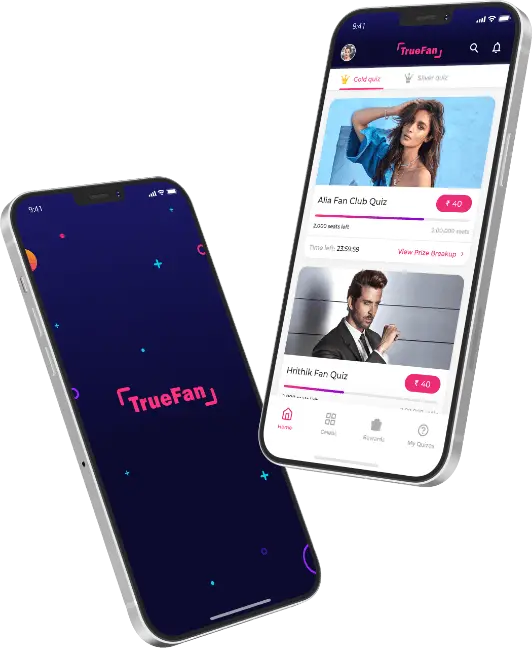16 Aug 2024
Mastering Mobile Game Development: A Comprehensive Guide to Building Your App
Shaun Bell

The mobile gaming applications have revolutionized the idea of gameplay in the palm. While their attraction has never lagged across age groups, cultures, and demographics, it’s compelling to all light gamers and passionate players. This fuel places the industry at the uppermost position in the global entertainment market. But what exactly makes them so compelling, and how have they reshaped our digital lives?
It’s convenient and available—where all the joy of mobile gaming is. The case is that, unlike traditional gaming platforms, mobile games were designed specifically for on-the-go gameplay: full-fledged gameplay experiences are now possible from anywhere at any time.
On top of that, brought along by the power of modern smartphones, portability gave way to the birth of aesthetically stunning and profound games surpassing their counterparts on specialized gaming consoles.
Another prime reason for their success with mobile gaming apps is their ability to appeal to various interests. Unwinding with some simple puzzle games, challenging oneself on a strategic RPG, or engaging in real-time multiplayer battles with people globally—a mobile game does it all. This type of diversity has propagated the gaming audience to reach very mainstream and heterogeneous users in general.
The line dividing casual from hard-core gamers becomes increasingly blurred, with mobile gaming at the front of augmented reality development, artificial intelligence, and cloud gaming. Much more immersive and interactive experiences, in this respect, await the future of mobile gaming applications, breaking every boundary for what may happen on a mobile device.
It’s an adventure interlacing creativity, technological expertise, and strategy in building a gaming app. Whether that is just being a self-published indie developer or a part of a more significant team, how to turn any game concept into reality is a multi-layered process of designing, developing, and testing. The difference, in a dynamic setting like this, between a hit and a miss lies solely in the integrated technique and technologies.
Defining your game concept is pivotal to having a clear vision of what you want your game to be, who it is for, and how it differentiates itself within the crowded marketplace. It provides a good base for all that follows. Whether this is an action/adventure game or a casual puzzle game, the concept leads development and drives decisions.
Growth Of Gaming Mobile App Development Company –
The quite outstanding growth of mobile gaming app development companies in Australia mirrors a dynamic tech landscape and a creative industry that is fast taking over the country. In the country, during the past decade, it has emerged as one of the renowned innovation game development hubs globally in mobile gaming. It is powered by the fusion of forces like a skilled workforce, pro-business government policies, and robust demand from home and global markets.
With high smartphone adoption and highly digital infrastructure in Australia, Australian developers could create mobile games that appeal across borders. A few titles developed in Australian studios that made waves in the world gaming scene are “Crossy Road” and “Fruit Ninja.” Encouraged by these successes, more start-ups and well-established mobile app development companies invested in mobile game development, hence a well-thriving ecosystem.
Apart from that, grants, tax incentives, and other efforts — such as the Interactive Games Fund launched by the Australian government — have gone a long way in supporting this nascent industry. By doing so, Australia can fit several gaming studios, from indies to larger companies, all working to enhance the country’s status as one of the crucial mobile game market actors.
Growth Of Gaming Mobile Apps Post-Pandemic
Growth for gaming mobile apps in Australia surged after the pandemic as part of a worldwide trend where digital entertainment squarely places itself at the core of engagement when people are locked down. Based on user penetration and resulting revenue data, the Australian mobile gaming market has rapidly grown since 2020, according to Statista.
This year, it is expected that the ceiling for the mobile gaming sector will exceed more than AUD 1.3 billion, a highly remarkable increase compared to the previous year. The larger picture that gave context might surpass the AUD 2 billion threshold by 2025. Such explosive expansion was caused by factors like increased usage of smartphones, more time staying at home, and a rise in interactive entertainment.
There are also steep hikes in the number of mobile gamers in Australia: over 10% from 2019 to 2021. It sets around 80% of the penetration and reach of mobile gaming among Australian Smartphone owners playing games on their devices as of 2023.
This growth was accompanied by a rush of development activity, and now Australian studios are increasingly interested in this platform. Not only did the uptake of gaming apps accelerate during this pandemic, but the mobile gaming industry itself was also positioned and set to become one of the main sectors of Australia’s digital economy that would expand further in the next few years.

What Is A Mobile Gaming App?
Mobile gaming applications are software programs designed for tablets and smartphones that enable players to play games on their mobile devices. The genres span from light, undemanding puzzle games to strategy-based RPGs, simulations, and fast action-adventure games, which may cater to several player preferences.
What sets these mobile gaming applications apart is accessibility and convenience. Mobile games are famous for on-the-go amusement because they can be played anywhere, unlike conventional gaming consoles or PC formats. Their touchscreen interface adds intuitive and interactive layers to the gameplay of mobile devices.
Additionally, to provide socially interactive and graphically rich gaming experiences, mobile gaming apps are created for new generations of smartphones equipped with sophisticated graphics, sensors, and networking functions. Most mobile games are designed to be gratis, with the income generated by in-app purchases and advertisements, hence their wide accessibility to large audiences.
In this fast-changing digital environment, mobile gaming applications will remain at the forefront of technology in entertainment, socializing, and education, sharing augmented reality experiences. It is their dynamic nature that keeps them at the forefront of growth and innovation within the gaming industry.
Perhaps unsurprisingly, several businesses have adopted the trend and developed mobile gaming applications. Your mobile game must be interesting for your app to be successful, given the intense competition and high development costs associated with iOS and Android apps.
Why Build a Mobile Gaming App?
Developing mobile gaming applications has great potential in the present digital era. The business of mobile gaming has grown tremendously due to the increased diffusion of smartphones and ever-growing demands for interactive entertainment. From this, it would be known that the global mobile gaming market would cross $100 billion by 2023, thus making it one of the topmost streams of revenue generation for developers and investors.
Another reason to invest in mobile game development is the broad audience. All age groups and demographic segments are involved in mobile gaming, thus ensuring a large user base. The potential size of the base itself of mobile gaming users is on the increase, and even non-gamers do some casual gaming.
Besides, it offers flexible monetization patterns for mobile gaming apps through in-app purchases, ad displays, and subscriptions. In particular, one of the freemium models has been very good: users download the game for free and pay to enhance the experience, thus keeping the entry barrier low while maximizing revenue generation.
Moreover, further innovation in mobile gaming is open to broad ways of development with advancements in technologies like AR and AI. These trends promise a better user experience and invite more gamers.
Thus, the development of a mobile gaming app can be a lucrative business that is responsible for bringing high returns on investment in the long run in the fast-growing gaming industry.
1. Growing Market–
The gaming market in Australia has witnessed rapid growth in recent years, with several individuals preferring them over traditional gaming consoles due to the convenience and affordability they provide. Accelerated growth in the mobile gaming apps market is characterized by the pervasiveness of smartphone adoption, increasing internet accessibility, and the trend towards shifting to mobile-first entertainment globally.
It is easily accessible, with multiple genres available, thus assuring great social connectivity features. The monetization opportunities through in-app purchases, ads, and subscriptions make mobile gaming profitable. Mobile gaming is developing into a rapidly expanding and profitable sector due to these technological advancements, including AR and VR, to improve user experience.
2. High Smartphone Penetration-
The Australian population leans towards technology and has adopted smartphones, creating a ripe environment for mobile gaming apps. One of the prime reasons for developing a mobile gaming application is the high penetration rate of smartphones and easily accessible audiences. With smartphones becoming ubiquitous and letting game developers reach different demographics easily, it has become accessible to millions of potential users.
Widespread adoption of devices will thus become an extensive market for mobile games, improving the possibility of involving more users and revenue. Moreover, today’s phones have strong processing capabilities and always available Internet connections, providing options for enhancing the gaming experience and innovative features.
3. Tech-Savvy Population-
The demand for mobile gaming apps is driven by a highly engaged population with digital technologies and has a demand for immersive and interactive experiences. They want cutting-edge gaming supported by superior graphics and seamless cross-platform compatibility.
They want an application that will give them social connectivity, options for customization, and real-time updates—features answering the demand for personalized dynamic entertainment. Thus, mobile gaming application development caters to the need for a sophisticated, engaging, and interactive gaming experience.
4. Supportive Infrastructure-
An underpinning infrastructure in a mobile game app is pivotal, as the robust ecosystem that enables it makes reliable cloud services scalable, fast content delivery networks workable through gameplay, and developed tools have easy coding.
At the same time, solid app stores and marketplaces provide wide distribution and visibility, while analytical and support services provide visibility into user engagement for discovering and fixing problems. It is an infrastructure that lets one have a smooth gaming experience, which is pivotal to attracting users and then retaining them.
5. Increased Monetization Opportunities-
Monetization is a brilliant opportunity for a mobile game app. Players can buy some of the virtual items or upgrades in an app. Some ads gain earnings through user engagement. Subscription models help avail premium content or features with steady revenue produced.
Lastly, partnerships and sponsorships with brands increase earning potential. That way, when combined, all these methods maximize the revenue potential of a developer through the rapid growth potential of the mobile gaming market and secure it as a most lucrative investment.
6. Thriving Start-up Ecosystem-
An innovation-perfect landscape is supported by a supportive policy regime, skilled talent, and rising investors backing an already vibrant start-up ecosystem in Australia. Building a mobile gaming app will stay in that dynamic atmosphere due to high smartphone penetration and a growing gaming community.
Opportunities for unique, compelling content and engaging experiences kick in, and start-ups can harness the demand for mobile entertainment to get significant user growth and revenues in a competitive market.
7. Global Reach-
Building a mobile gaming application in Australia means reaching out to the world due to the country’s sound digital infrastructure and high smartphone penetration. Gaming has a significant growth market in Australia, complemented by a tech-savvy population and strong gaming culture.
By developing a mobile game structured according to Australian preferences, tapping into the local opportunity also opens up greater visibility globally, given Australia’s position as a gateway to the rest of the larger Asia-Pacific region, where the game development industry is booming in other countries as well.

How To Build A Mobile Gaming App ?
A mobile gaming app that combines creativity and technology must have a compelling concept that draws the player in with appropriate gameplay, eye-catching graphics, and simple user interface (UI) design. Though the player has to be catered to, this should always be backed well to manage the player data and to work impeccably. Social features and in-app purchases complement the user experience and how the product is monetized. A few of the most pivotal gameplay parts include testing and improving the application based on the feedback received. Keep it fresh by following industry trends and include new, innovative features to make the game exciting and relevant.
1. Finalize Your Game Idea –
The first and foremost step to developing a mobile gaming app involves app developers and brands deciding on the story for their game before they start building the mobile game. It is the stage where you finalize your story and idea for the game. At this point in the process, you refine your mobile game’s main idea, story, and gameplay elements.
Clearly define the storyline, characters, and all the objectives given the target audience and genre of the game. It is also pivotal to work on the game’s unique selling point, build a consistent game world, and chart progress and challenges. This base will guide further development processes affecting the design, programming, and overall player experience.
2. Market Analysis–
After you have finalized your game’ idea and a compelling storyline, you need to analyze the market and understand what would work in the market and what you need to offer to stand out amongst your competitors. This phase of the mobile game application development process involves continual research into the current environment in which games are situated.
This approach starts with identifying target audiences, analysing competitor apps, and evaluating market trends and requests. All this is very important in defining unique selling points, strategies in pricing, and marketing approaches. It ensures that the app answers the needs of the markets and is different amidst competition.
3. Choose Your Mobile Apps Technological Stack–
After you have finished analysing the market and are satisfied with your idea, you have to choose the technologies you want to incorporate into the app to ensure your users have a brilliant overall experience. Choosing the technological stack for a mobile gaming application means selecting appropriate development tools and technologies.
It means choosing a programming language, for example, Swift for iOS and Kotlin for Android, game engines like Unity and Unreal Engine, and libraries for graphics and physics. Other technologies at the back end do all the server-side operations, while databases are in charge of data storage and third-party services for analytics and in-app purchases. This choice affects performance, scalability, and the overall user experience.
4. Plan Your Mobile App’s Design And Graphics–
Another pivotal step in building a mobile gaming app is planning the graphics and design to ensure you offer unique and attractive graphics to your users to retain them long-term. Designing and planning graphics for a mobile app involves setting visual style and UI and UX to create an engaging yet intuitive game. Sketch out several concepts for game elements, characters, and environments.
Define the colour scheme, typography, and design motifs that best fit the underlying theme of your game. Draw high-fidelity mockups and prototypes demonstrating the gameplay, navigation, and interactions. A website design has to be good-looking, user-friendly, and optimized for as many devices and screen sizes as possible.
5. Choose Your Mobile Platforms-
After you have concluded the graphics and app designs, you will have to choose from the several available mobile platforms to launch your app and make it an instant success among users. Another significant choice in mobile gaming application development is the choice of mobile platforms, meaning choosing between operating systems on which your game has to be launched: iOS, Android, or both.
It affects your marketing reach, budget, and development strategy. They include money flow, features on the platform, and the target audience. Choosing the right platforms ensures your game works properly and reaches the targeted audience.
6. Plan A Monetization Strategy-
Well, I am sure if you are planning to enter the mobile game development market, then it is to generate revenue and make big bucks. The Plan A Monetization Strategy step in the development process is where the design of how the game will make money has to be defined.
It is accomplished by selecting a profitability strategy like pay-to-download, in-app purchases, advertisements, or subscriptions. Considerations to this point in the process include user experience vs. revenue goals and competitor strategy analysis, with an estimate of possible revenues. The plan should fit the game’s design and target audience to guarantee maximum profits without sacrificing player interest and satisfaction.
7. Testing And Debugging-
Once the app’s planning and charting are complete, it is necessary to test and debug it before releasing it to the public to ensure that it functions flawlessly and offers users a brilliant experience. Testing and debugging are the two most important stages of developing any mobile gaming application.
It means tightly checking the game for problems related to performance, functionality, and compatibility with different hardware and operating systems. It is achieved through the debugging process, in which the developer finds and fixes errors or malfunctions discovered in the application during testing. It allows the game to function smoothly and offers a consistent user experience with quality requirements, which must be fulfilled before the game’s release.
8. Launch Your App-
The “Launch Your App” step involves finalizing and launching your mobile gaming app into the app stores. In this stage, the app is extensively tested to ensure there are no bugs and runs well across all platforms. This would also cover information from the App Store page, like captivating descriptions, excellent images, and marketing collateral.
Enhance the app with relevant keywords so that it has good search visibility. Submit it on iOS and Android after meeting the standards of both platforms. On approval, trace the app for functionality, user reviews, or other issues. Run the updates and market users with your tactics. For long-run support, updating is mandatory.
9. Maintenance And Support-
It means maintenance and support for the mobile game application that involves activities far beyond the development process itself to ensure the performance and user satisfaction level of an app.
This phase is focused on monitoring bugs and glitches, updating the app in the face of new OS versions, and implementing user feedback for improvements. Regular updates can add new features or content to retain interest. Support includes answering user questions and resolving issues immediately while ensuring the stability of servers for online games. In this way, continuous care is pivotal for player retention and longevity in a competitive market.

Key Features to Offer in Your Mobile Gaming App-
While developing a mobile game application, key into features that enhance user experience and engagement. Find features that make sure the experience is uninterrupted and enjoyable right from the first second user experience with your application. The User Interface needs to be such that it offers easy navigation options with low learning curves.
It should be optimized on different devices and screen sizes to increase its audience. Provide mechanisms encouraging user participation with the app, and sharing on social media. Continue updating and supporting the solution of problems so gamers experience new and exciting gaming experiences.
1. User-Interface
A human-centred design for a gaming app is intuitive, allowing the user a simplistic and easy way to navigate through it. It should be clean, not cluttered, and have icons and some recognizable gestures, typically in the form of swipes or taps, for the user to transit through it effortlessly.
The way it is, the user interface adapts to each user’s behaviour at the time by showing them personal shortcuts and tips they could use while playing. Interactive tutorials bring new users up to speed without overwhelming them. The responsive design allows seamless transitions between menus and in-game actions, with quick access to necessary controls. Visual feedback, like subtle animations, helps enhance the in-game experience.
2. Engaging Gameplay-
An aspect of the game that dynamically adapts in real-time to the player’s actual skill level. This system gives personalized challenges based on in-game behaviour, consisting of skill task combinations, time-limited missions, and puzzle elements.
The better one is in the challenges, the more difficult they get, so it prevents the lack of engagement. Besides, the system rewards unique in-game elements, achievements, and leaderboards that further give a sense of progression and competition to players. It ensures the gameplay stays fresh and draws players back in with continuously more rewarding experiences.
3. Social Integration-
It is a feature of any mobile gaming app that allows players to connect with and interact through the app with friends and other players. Other added features under the said feature are in-game chats, friend lists, and multiplayer modes where players may join others or play in real-time.
Users can get social share options like posting achievements, scores, or milestones on various social media platforms. It can also provide leaderboards, guilds, and tournaments to bring out the community feel. By enabling collaboration and healthy competition, social integration will enhance the gaming experience and encourage sustained play, ensuring more gamers stay playing.
4. In-Game Rewards And Monetization–
Rewards and monetization within the game are crucial for a mobile gaming app in the context of player engagement and bottom-line growth. Players can receive rewards in virtual currency forms, power-ups, or exclusive items upon completion of given tasks, reaching key milestones, or participation in a specific event.
The rewards could be commercialized by the players through in-app purchases to get more currency or premium items. Furthermore, ad-based rewards—like video watching for bonuses—open another revenue stream while keeping the game accessible to free-to-play users. Balancing rewards versus monetization speaks to long-term player satisfaction. A leading mobile gaming app development company can help you understand the available monetization strategies and the best choice from them.

5. Offline Playability –
Offline playability in mobile gaming applications refers to the capability of a user to execute the application in an idle state of an internet connection. It is another pivotal feature ensuring user experiences, especially in areas that lack proper connectivity.
It ensures that the flow of gameplay is without glitches because all essential data about the game gets stored on local devices. The player can access any set of levels, challenges, or modes while offline, and after the connection returns, their progress and status will only synchronize with the server.
6. High-Quality Graphics And Sound–
Mobile gaming app’s graphics need to be breath-taking and ultra-realistic, with 3D environments, detailed textures, dynamic lighting, and smooth animations. The characters must look alive, with great designs and fluid moves. Reflections, shadows, and particle effects are a significant part of visual effects that give more depth and make it more immersive.
Spatial audio creates experiences with actual environmental sounds and sound effects, which move in response to the player’s movements in a surround sound manner. The game world is complemented by high-fidelity background music and voice acting, guiding through every aspect. The adjustable sound configuration gives a quality experience on a range of devices. A mobile gaming app development company can help you create high-quality graphics and sound effects for your mobile gaming app.
7. Personalization And Customization–
One of the prime ways to maximize user engagement in mobile gaming apps has been through personalization and customization. Personalization in mobile gaming refers to segments of the game getting adjusted according to a player’s behaviour and preference for different elements like difficulty levels, the rewards system, and game content.
Customization allows users to change their avatars, skins, and game settings to what they like. It is a pivotal point that enables users to feel a greater connection to the game, as they can identify and enjoy it, thus increasing the perceived satisfaction. It facilitates continued usage by users because it gives them the sense of being in adjustment to the experience. Hire an Android app development company or an iPhone app development company depending on your needs to build your dream gaming app.
8. Onboarding Process–
A good onboarding experience in a mobile gaming app is one of the determinants of user retention and engagement. It should be intuitive, attractive, and informative, leading new players through pivotal features and gameplay elements. An interactive but concise tutorial would allow users to feel comfortable with controls, objectives, and rewards without being overwhelmed.
Tailored features like choosing avatars or game difficulty allow for an experience tailored from square one. Social media logins provide a seamless account set-up opportunity so that everything can fly. Hire a trustworthy mobile app development company to help you understand the market needs and wants to ensure your app becomes successful in the market.
9. Login/ Sign-Up–
One should be able to log in to a mobile gaming application smoothly and effortlessly, with several options for signing in through email, social media accounts, or phone numbers. There has to be very high security with password authentication.
To make it more convenient, this would entail having the option to enable biometric verification by fingerprint or facial recognition. The login interface should be clean, evident with prompts, and easy to navigate. Add on features like “Remember Me” and “Forgot Password?” options to make it easier for returning users to join quickly.
10. Push Notifications–
Push notifications in a mobile game app means small messages related to timing that keep up engagement and inform users about the game updates, special events, or rewards. They can incentivize players to return to the game by giving information on new features, limited-time challenges, or exclusive in-game offers.
The application of notifications can extend to push notifications, warning users of friend activity, game progress, or achievements. By offering both personalization and relevance in context, push notifications can increase engagement and retention among players, eventually and effectively driving users back into the game and keeping them connected to the gaming community.
11. Community Support –
Community and support allow players to engage through provisional tools for communication and help. Most of the time, this includes in-game chat systems, forums, and integration into social media sites for networking among players to hook up, share experiences, or collaborate.
This feature also offers robust support options like FAQs, in-game help, and customer service channels to make the handling of technical issues or gameplay questions easier. By way of building an engaging community and delivering robust support, the app improves user satisfaction through retention and the creation of a positive gaming environment where, as a whole, players feel valued and heard.
A trustworthy mobile gaming app development company provides excellent quality and innovative solutions to ensure an interesting yet safe and smooth user experience.

Types Of Mobile Gaming Apps You Can Build–
Many formats for mobile gaming apps create different experiences. Each could be fitted with choices for unique tastes and playing styles: quick sessions or immense adventures. They may bring about strategic thinking, fast-paced action, creative problem-solving, or cooperative gameplay. There is something to captivate every type of gamer thanks to the enormous feature variety.
1. Casual Gaming Apps–
Casual gaming apps are supposed to offer quick, light, and fun gameplay, requiring neither long-term commitment nor advanced skills. Effortless mechanics and intuitive control, with short play sessions, make it all suitable for each kind of user. Many of these types of apps include genres of puzzles, match-three games, and endless runners that provide relaxed entertainment due to the instant rewards that can be gained. A mobile app development company can help you build the gaming app of your dreams in your budget.
2. Puzzle Games-
Puzzle gaming apps engage players with brain-teasing problems and logic-based tasks to help develop their critical thinking skills and problem-solving. These apps come with several puzzles—jigsaw, crosswords, and match-three games—together supplying the initiative towards mental agility and creativity.
The players advance to the solution of increasingly complex puzzles, earning rewards and unlocking new levels. Graphically lively and interactivity-rich, a puzzle gaming app provides an enjoyable intellectual workout with entertainment for the user. The experience will be similar to what any other person who loves strategy or intellectual games might expect from a good and mentally challenging game.
3. Arcade App-
Arcade gaming applications deliver fast-paced and full-of-action experiences, much like classic arcade games. In most cases, these apps would mean quite simple controls, challenges of high scores, and engaging game loops developed for quick, repetitive gameplay. Often, players compete to score as high as possible or finish levels against progressively challenging obstacles.
The games are addictive, fun, bright with graphics, and have catchy soundtracks that attract players seeking nostalgic experiences and those seeking instant fun with competitive thrills. A trustworthy gaming mobile app development company like 7 Pillars can help you build your dream arcade game app within your budget.
4. Action Games–
These action gaming apps are in a class of their own with their fast-paced, adrenaline-filled games. This essentially contains fast-paced fighting, speedy chases, and other challenges requiring quick reflexes and thinking.
It means that players participate in combat mechanized scenarios, obstacle courses, or missions in real time. Most apps incorporate good graphics, immersive sound effects, and sometimes even real-time multiplayer options for added excitement and competitiveness in a game. Nonstop action and ever-changing gameplays aim at keeping players interested.
5. Adventure Games–
These are adventure game applications that engross users in an exciting storyline or the luxurious, most interactive worlds. Mostly, they feature exploration, solving puzzles, and narrative gameplays that allow the user to go questing and solving mysteries.
Players can wander through detailed environments, communicate with characters, and make choices that may alter the path of history. Most adventure gaming apps are focused on storytelling and creating compelling characters, which gives users a sense of progression, especially while discovering secrets or overcoming challenges in the virtual world.
6. Simulations Game-
Simulation gaming apps are non-ideal models of reality that replicate real-world systems and processes. Through these applications, users are exposed to expansive landscapes where they can handle intricate activities, make strategic choices, and interact with the dynamics of that specific environment.
Games can simulate running a business, managing a city, or controlling intricate machinery. By simulating real-life activities and problems, these apps provide hands-on experience that encourages problem-solving and strategic planning with creativity, thus providing brilliant player appeal where realistic and immersive gameplay is enjoyed.
7. Multiplayer Online Battle Games –
MOBA stands for Multiplayer Online Battle Arenas. These are game applications where players in teams compete against each other in a virtual battleground. Each player controls a particular character who has different abilities, with the prime objective of trying to complete their set and defeat the other team.
These games chiefly focus on strategy and teamwork that incorporates tactics. They are characterized by complex maps, various heroes, and real-time combat. In many instances, MOBAs encourage both collaboration and competitive play, ensuring continuous action that is fast-paced together with coordination and strategic planning to win.
8. Education Games–
Education gaming apps have interactive gameplay with educational content to keep learners involved in learning. Gameplay mechanisms teach Math, Science, Languages, History, etc. Almost all learning apps incorporate quizzes, challenges, and rewards to stimulate learners and increase retention while enriching problem-solving skills. They try to make education entertaining and fascinating to improve knowledge gain and retention and, in the process, address individual differences in learning styles and ages.

How Much Does It Cost To Build A Mobile Gaming App?
The budget for developing a mobile gaming application in Australia differs tremendously based on various variables: level of complexity, features involved, and the rates of the development team.
The development cost for a primary or simple mobile game application will cost anywhere from AUD 50,000 to AUD 150,000. The price for more complex games comes with advanced graphics, multiplayer functionality, and in-app purchases, raising the cost through the roof to anywhere between AUD 150,000 and AUD 500,000 or more.
A few key factors affect the cost:
- Game Complexity: Less complex games come cheap, and highly detailed designs using 3D graphics with complicated mechanics are expensive.
- Platform: Development cost increases if versions have to be made for too many platforms, let’s say for both iOS and Android.
- Design and Animation: High-quality graphics and animation increase the cost of development.
- Features: Options like multiplayer, in-app purchasing, or integration with social media increase development costs.
- Development Team: The cost will differ based on whether you work with an Australian-based development team or contract with foreign developers.
This could include more things like marketing, maintenance, and updates. Proper planning and obvious requirements will ensure the project doesn’t go off track due to poor expenditure planning.
Conclusion–
An effective mobile gaming app brings creative design, robust technology, and strategic planning. First, there should be an understanding of the target audience and the market trend to understand what type of game and concepts are needed. Engaging gameplay with compelling graphics forms part of the strategy to capture and hold players’ interest, coupled with intuitive controls for a seamless user experience.
7 Pillars, a brilliant mobile app development company, can help you create a well-planned and engaging mobile game app that will be an instant hit in the market after analysing the needs and wants of the target audience.
The development of mobile gaming apps must adhere to a clearly defined roadmap with prototyping, testing, and iteration stages. It can be streamlined using contemporary development frameworks and tools that make development and deployment easier and faster. At every stage of performance enhancement, great care must be taken to ensure an uninterrupted gaming experience across multiple devices and different operating systems.
7 Pillars is a beloved mobile app development company that designs innovative, high-performance apps and solves real-world issues as per the needs of clients. They focus on the latest technologies and ensure optimal user experience to drive success and growth in the digital space.
It comes down to this: a well-balanced combination of creativity, technical expertise, and foresight in strategy will help grow a successful mobile game. By focusing on an entertaining yet safe user experience while keeping up with the evolving market, developers can create a game that speaks to players and stands out within an overwhelmingly saturated app marketplace.
If you are an entrepreneur raring to turn your dream about a mobile gaming app into a reality, let 7 Pillars, one of the most innovative and creative mobile app development companies, hear from you today.




















